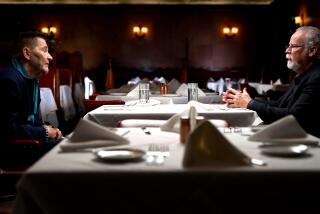Students Unfazed by Film on Teen Deaths
- Share via
Fifteen-year-old Orlando Reneau stood motionless in the huge gymnasium, hands stuffed into the pockets of his drooping khaki pants, searching for some meaning in the dramatized carnage he had just seen.
In re-enactments of scenes too often real for Reneau, a teen-age boy gunned down a rival; an ambulance rushed a bullet-riddled youth off to the hospital; a young girl sobbed relentlessly over the corpse of her murdered boyfriend.
As he had watched the U.S. Health Department film commentary on teen slayings with the nearly 100 other South Los Angeles residents at the Challengers Boys and Girls Club on Wednesday night, Reneau said, something had told him that he was supposed to be moved, that the make-believe bloodshed was meant to inform, to stun.
But the 15-year-old remained strangely unfazed and none the wiser.
“OK, a lot of it was true,” Reneau said, shrugging and staring at the gym floor. “That’s what’s happening on the streets, but I knew that. It didn’t scare me or anything. The message was that the streets are rough. Man, I knew that, too.”
Such was the reaction of many of the parents and teens who watched “Youth Homicide: A Public Health Issue,” a film that deals with teen killings as a health crisis as well as a legal issue.
It was interesting, they said, but in the end the film was just another palliative for the social problems plaguing their communities.
The production, which the U.S. Department of Health and Human Services filmed last year, pairs the disturbing murder re-enactments with comments from convicted killers and community activists on the social ills that fuel the steady increases in youth homicides.
“It’s time to stop thinking about youth homicide purely as an issue of criminal justice,” said Mariam M. Bell, a Health Department spokeswoman, who attended the showing. “It is time to start considering it instead as a preventable public health problem. It is a problem that demands the immediate attention of each and every one of us.”
In 1987, she noted, more than 26,100 youths died in homicides.
Bell said the film, which her department prepared in conjunction with the Howard University campus television station, premiered last year in Washington.
Among the activists honored and quoted in the film was Lou Dantzler, founder and executive director of the Challengers Club on South Vermont Avenue. Dantzler said he hoped the film, in which he describes the objectives of the club, would galvanize viewers.
“Hopefully, it will have some impact,” said Dantzler, whose organization has gained national attention for its work with Los Angeles youths ages 6 to 17. “A film like this is necessary because it makes you think.”
While some acknowledged that the film was poignant, they hastened to add that it only mirrored an environment they know well.
“I’m here in this community every day, and I see what was shown in this film every day,” said Occerita Oliver, who attended the showing with her 10-year-old daughter, LaTresha. “The children and some of their attitudes are the same. Some of these kids can’t tie their shoes, but they can curse you out or hold a gun.
“The film didn’t present anything new to me.”
Reneau and Robert Arias, 17, said that, despite the film’s intentions, only concrete social programs could curb the teen-age violence that has wracked their neighborhoods.
“We’re trying to get out of that type of stuff by coming here,” said Arias. “The club is helping us. The film was truthful, but the club gives us someplace to go.”
Despite the lukewarm reactions from many in the audience, others said they were deeply touched by the film.
“It had a real effect on me,” said Dwyane Poole, 21, one of several Los Angeles Police Department Explorer Scouts who watched the program. “I thought about what it was like for me when I was out there on the streets. I could have been out there killing, or doing crime, because I didn’t have anything to do.”
More to Read
Sign up for Essential California
The most important California stories and recommendations in your inbox every morning.
You may occasionally receive promotional content from the Los Angeles Times.










